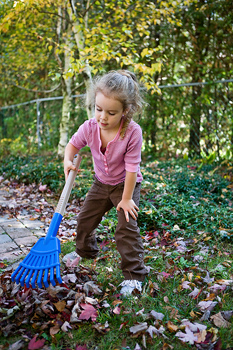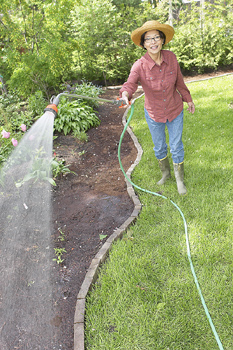Seasonal Lawn Tips
A lawn needs attention in early and late spring, summer, and fall. In all but the most southern zones, it is dormant in the winter months.
Here's a season-by-season rundown for your yard. Dates mentioned are for mid-America; figure two to three weeks earlier in the south, and two to four weeks later in the north.
Early Spring Lawn Tips
 Grass comes alive with a spurt of growth in early spring. If you did all the right things last fall, you shouldn't have much to do other than the following: Grass comes alive with a spurt of growth in early spring. If you did all the right things last fall, you shouldn't have much to do other than the following:
Fertilize only if you didn't do so in the fall, or if winter kill has been severe. Spring fertilizing will feed the grass leaves more than the roots, so be prepared for early mowing.
Rake all debris off the lawn. Seed any bare spots around mid-April.
Attack crabgrass or quack grass before it can germinate. Check with a local nursery to see when germination occurs in your area. Use a fertilizer spreader to spread a pre-emergence herbicide before that time.
Water only if rainfall is so light that there is not 6 inches of penetration in a week.
Mow to about 2-1/2 inches in height. Rake up the clippings. They will be dense and can overwhelm the lawn if not removed. Dry them to use as mulch if you wish.
Late Spring Lawn Tips
By the first weeks of June it is too late for major renovation, seeding, and fertilizing, but during late spring you should:
Rake lightly to remove dead grass and old leaves. Grass can't live under such debris.
Hand-seed small bare patches. Late spring isn't the ideal time to seed, but you need to get grass instead of weeds into the bare spots.
Water thoroughly once a week if it doesn't rain. Check for 6-inch penetration and adjust your watering schedule as necessary.
Fertilize only if you did not do so last fall or in early spring, or if your lawn looks like it is not doing well. A slow-release organic fertilizer is best at this time of year.
Mow often, but not too short. Cut to about 2-1/2 inches high, and frequently enough so you never need to remove more than one-third of the green growth at a time. Bag thick, moist clippings; if left on the lawn they can smother growth beneath them.
Summer Lawn Tips
 Lawn care in late June, July, August is much the same as in late spring, with the following exceptions: Lawn care in late June, July, August is much the same as in late spring, with the following exceptions:
Water more frequently during hot, dry weather. The soil needs a 6-inch penetration about every five days. This is especially important if you're growing a rich lawn with more than one or two fertilizer applications a year. In addition, in very hot weather a light sprinkling just after hottest part of the day, only enough to thoroughly moisten and cool the lawn, can help relieve heat stress.
Mow a bit higher -- about 3 inches is ideal. Taller cutting increases the grass's food-producing capacity and encourages deeper, more drought-tolerant roots. It also helps the lawn hold moisture and discourages weeds. You should be able to let the clippings from summer cutting remain, to put nutrients back into the soil.
Spot-spray to keep dandelions and other invasive summer weeds in check.
Fall Lawn Tips
Around the first week of September, lawns in most areas of the country begin a new growth spurt after the hard times of summer. Water and mow as in the late spring, and do most seeding, fertilizing, and weed control now. If your lawn needs more than basic maintenance, this is also the time to de-thatch or aerate it.
Use patch and fill-in seeding to take care of bare spots and areas where grass is thin.
Fertilize your lawn around mid-September to get the best results. Leaf and stem growth slows in the fall, so the nutrients you add will mainly feed the roots. The type and amount of fertilizer to use depends on your lawn's condition and partly on the severity of winters in your area. Be sure to get advice from local experts.
Attack dandelions and broadleaf weeds if spot-spraying them in the summer failed to wipe them out. Apply either a combination of weed killer and lawn food or a separate broadleaf herbicide. In areas where crabgrass and other weeds have taken over more than half the surface, spray with a non-selective herbicide. Wait a week or more (as prescribed on the herbicide label), then clear away the dead growth, loosen the soil surface with a garden rake, and sow new seed.
De-thatch your lawn to remove accumulated layers of grass plants and roots if thatch buildup is more than 1/2 inch thick.
Aerate the lawn to promote healthy root growth and prevent thatch buildup. The best time is from late August to mid-September, but aerating at other times can be successful. Contact us at 706-206-9166 or click to fill out our online quote request form.

"In God We Trust"
|